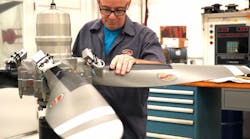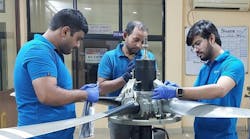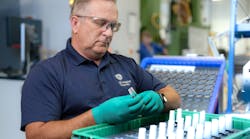Propeller imbalance is a key problem on all turboprop aircraft – whether military, commercial, or general aviation. Overcoming propeller imbalance is crucial to the efficient operating performance of turboprop aircraft. Propeller imbalance leads to excessive vibration which causes fatigue in aircraft components and subsequent structural failures. The negative effects of vibration are also responsible for passenger discomfort and excess fuel consumption.
Keeping vibration under control and monitoring its effects to predict potential failures requires significant expenditures. The need to take aircraft out of service to periodically balance the propellers results in increased labor and maintenance costs. There are safety considerations to take into account as well. Engine failure due to vibration or fatigue could cause an accident, or the necessity to abort a flight.
In-flight balancing
To counteract the negative effects of propeller imbalance, a new technology – an in-flight propeller balancing system (IPBS) - has been developed. Active balancing technology for aerospace and military applications has been in development for almost a decade in conjunction with the U.S. Air Force (USAF) and the U.S. Navy. It has logged millions of service hours in applications from turbo-compressors to large extraction fans to high-speed machining spindles.
The IPBS continuously and actively balances propellers during flight operation. The result is propeller balance maintained at the highest possible level during the entire flight. By reducing propeller imbalance at the source – the propeller – vibration and its negative effects are alleviated. With an IPBS, structural fatigue is reduced, engines run more efficiently, spare parts will run longer, and safety concerns are mitigated.
Presently, to overcome propeller imbalance, an aircraft must be taken out of service every few months. For example, on the USAF’s C-130H cargo aircraft it takes approximately two to three days and a crew of three to five workers to manually balance the propellers. The traditional method of dynamically balancing propellers – adding counterweights – allows for proper balance at one specific operating condition, and for only a limited amount of time since the propeller blade angle and aerodynamic loads will change during flight.
A manually balanced propeller is only effective for the conditions on the ground during that particular point-in-time. As soon as the aircraft resumes operation, the propeller will be out of balance again. Manually balancing the propellers is not only ineffective, it is a labor-intensive and costly process that keeps an aircraft out of operation for several days.
Balancing benefits
The IPBS consists of one balancing device per propeller and a single controller per aircraft. This computer-controlled system uses input from the rotating propeller to automatically adjust the balance as needed to minimize total system imbalance for each operating condition. It features a series of imbalance weights configured in a ring. The ring is then connected to a centralized controller.
With IPBS, propeller imbalance is continuously monitored. When an imbalance condition occurs, a series of magnets within the balancer are actuated. These magnets shift the imbalance weights and bring the propeller back to a balanced condition. Not only does the IPBS eliminate the need to rebalance propellers on the ground, the system itself requires very little maintenance.
Controlling vibration with an online, automated balancing system offers the benefits of increased structural durability, less stress on engine components, reduced maintenance workload, and lowered operations costs. Safety concerns due to improper propeller imbalance are eliminated, and a smoother ride is provided for the air crew.
In addition to managing propeller imbalance, the IPBS can also serve as a predictive maintenance tool. For example, if the IPBS is continually balancing one specific quadrant of a propeller, this could indicate a problem with the propulsion system. Ground maintenance crews can then address the problem and use the IPBS readings for diagnostic information.
Military applications
The IPBS has been adopted for use on all of the USAF’s 200-plus C-130H fleet equipped with 54H60 propellers. Operational and evaluation testing was completed in February 2013. Testing consisted of more than 9,000 balance operations during the flight test. In essence, the propeller was rebalanced approximately every 1.3 minutes of flight time. Traditional manual balancing requires the USAF to perform balancing operations, on the ground, every 135 days.
Per USAF requirements, propellers must be balanced to 0.2 inches per second (ips) of vibration. With the IPBS, the propeller is continuously balanced to below 0.05 ips throughout the course of the flight. Not only is the propeller continuously balanced regardless of flight conditions, but the balancing is performed to a level that is much less than what the Air Force manually balances.
Military testing
The USAF testing process was initiated in 2004. At that time, a four-hour flight test was conducted with sponsorship and oversight from the USAF Air Mobility Battlelab and engineering support from the Robins Air Force Base, GA, C-130 System Program Office (330th ASG). The demonstration began with the installation of an IPBS on a 54H60-91 Hamilton Sundstrand propeller system.
Several typical flight profiles were conducted with the support of the 339th Flight Test Squadron of Warner Robins Air Force Base, GA. Although vibration levels varied throughout the power spectrum on the 54H60-91 propeller, once activated, the IPBS proved it could maintain vibration levels at approximately 10 to 20 times less than any condition between thrust reverse (-6,000 inches-pounds torque) and maximum power (18,600 inches-pounds torque).
Throughout this operating range, the required balance corrections varied in both amplitude and in angular position. In addition, the performance of the IPBS was unaffected by ambient air temperature from ground to 20,000 feet. The data gathered demonstrated that the IPBS is capable of performing required corrections automatically and reliably, with no additional workload for the flight crew.
In 2009, the IPBS was flight tested on four propellers at Kirtland Air Force Base, NM. The system performed at expected control levels throughout the flight profile. Vibration on all four engines was reduced to <0.05 inches per second during all flight conditions. Overall, the tests showed a 94 percent reduction in propeller vibration levels and a 75 percent reduction in propeller-induced vibration measured at the compressor.
Proven technology
These tests demonstrated that the IPBS concept is a robust in-flight system for turboprop aircraft. It can produce significant operations and support savings, realized by eliminating the lengthy maintenance actions required to periodically balance propellers per the requirements.
For the USAF, the reduced maintenance will help to increase readiness by returning aircraft to the operational squadron earlier. Further, the large reduction in propeller vibration will provide a significant decrease in the maintenance cost of engine, gearbox and airframe-mounted equipment. Presently, the USAF is testing the IPBS to a 6,000-hour mean-time-between-failure (MTBF) on the C130H aircraft, which is nearly the life of the aircraft.
A variant of IPBS is currently undergoing testing on the Navy’s LCAC (Landing Craft, Air Cushioned) vehicles used for transporting personnel, weapons, equipment, and cargo ship-to-shore and across beaches. The Navy is also looking into installing the IPBS on its E-2 Hawkeye tactical battle-management airborne early-warning, command and control aircraft. Future installation possibilities for the IPBS include commercial applications on regional turboprop aircraft.
IPBS can provide lower operating and sustainment costs, reduced aircraft downtime and maintenance workload, and improve the reliability of engine-mounted components on turboprop propellers. As a result, military and commercial operators of turboprop aircraft will be able to more effectively accomplish their organizational missions.
Justin P. Manna is the senior business development manager for Air Force programs at LORD Corporation. In his role, he is responsible for the marketing, sales, and customer support for active balancing technology, military applications. Prior to his current position with LORD, he served eight years as an acquisition and public affairs officer with the United States Air Force and Air Force Reserve. While there, he served in the C-17 and C-130 System Program Offices at Robins AFB, GA, as well as with the 439th Airlift Wing at Westover Air Reserve Base, MA. Justin holds a Masters of Business Administration from Boston College and a Masters of Public Administration from Georgia College. For more information visit www.lord.com.





